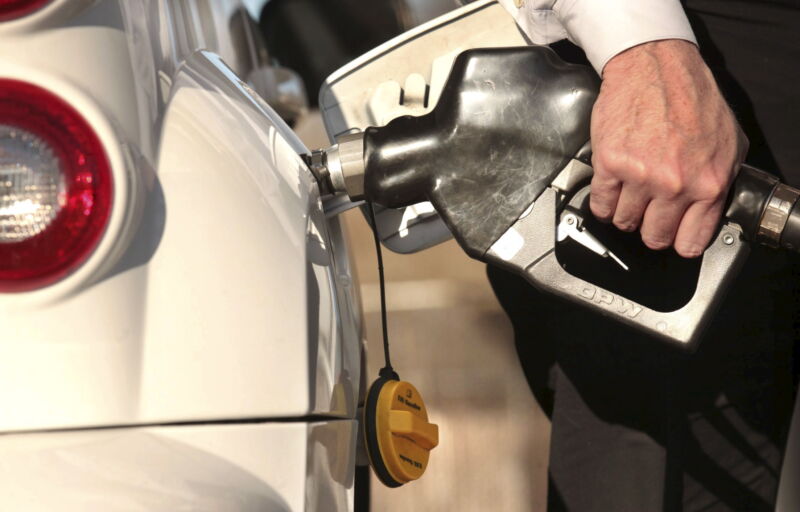For over a decade, the US has blended ethanol with gasoline in an attempt to reduce the overall carbon pollution produced by fossil fuel-powered cars and trucks. But a new study says that the practice may not be achieving its goals. In fact, burning ethanol made from corn—the major source in the US—may be worse for the climate than just burning gasoline alone.
Corn drove demand for land and fertilizer far higher than previous assessments had estimated. Together, the additional land and fertilizer drove up ethanol’s carbon footprint to the point where the lifecycle greenhouse gas emissions—from seed to tank—were higher than that of gasoline. Some researchers predicted this might happen, but the new paper provides a comprehensive and retrospective look at the real-world results of the policy.
Proponents have long argued that corn-based ethanol bolsters farm incomes while providing a domestic source of renewable liquid fuel, while critics have said that its status as a carbon-reducing gasoline additive relies on questionable accounting. Based on the new study, both sides may be right.
Rosy predictions
Ethanol as a fuel has long been contentious in the US. It started being added to gasoline nationwide in 2006, and the amount has been ramped up in the years since under the federal Renewable Fuel Standard (RFS), a key plank in the bipartisan Energy Policy Act of 2005 that was signed into law by President George W. Bush. Today, most gasoline sold in the US contains 10 percent ethanol, and about a third of the corn crop in the country is used to produce the fuel. While other sources would qualify, including ethanol derived from cellulose, “most RFS biofuel production has come from conventional corn ethanol,” the study’s authors pointed out.
The researchers studied the issue from several angles, including examining how much additional land was needed to grow the corn, how much extra fertilizer was used, what the combination of the two did to water quality, and how crop prices changed in response to the RFS. The team looked at those changes between 2008—the year after the law requiring the standard was passed—and 2016.
When the law was first implemented, corn ethanol barely qualified for inclusion in the RFS program. In the initial regulatory impact analysis, US emissions from land-use change were predicted to decline slightly, while those abroad were expected to rise significantly. (The international increase was anticipated due to supply-and-demand shifts in the global market for crops.)
“To comply with the policy’s GHG [greenhouse gas] reduction goals, the RFS requires conventional renewable fuels to generate life cycle GHG savings of at least 20% relative to gasoline,” the researchers wrote. “Upon enactment, the policy’s regulatory analysis projected that life cycle emissions of corn ethanol production would just clear the 20% threshold by 2022, even when emissions from [new farmland] were included.”
But the new study says that as a result of new farmland being tilled and old farmland not being retired, emissions from land-use change and fertilizer use in the US increased nearly 50 percent above the regulatory analysis’s estimates that allowed corn ethanol to barely qualify.
The researchers found that in response to the new demand, farmers tilled an additional 2.8 million hectares (6.9 million acres) for corn that otherwise would have been left alone, an 8.7 percent increase. Since corn needs a lot of nutrients to grow, fertilizer use shot up by 3–8 percent.
The extra land put under the plow released a significant amount of carbon, enough to flip the assessment of corn ethanol from a carbon-negative fuel to a carbon-emitting one. The biggest decline came when new cropland released carbon that had been stored in soils and vegetation, including roots of living plants. Farmers were also less likely to enter a field into the Conservation Reserve Program, which pays farmers to plant perennial vegetation on unused farmland.
After the fertilizer was applied, it released a significant amount of nitrous oxide, a potent greenhouse gas that warms the atmosphere 300 times more than the same amount of carbon dioxide over 100 years. The researchers’ estimates of the carbon impact of the fertilizer are probably low, too, since the authors didn’t calculate how much additional pollution the manufacturing process released or the extent to which degraded water quality in downstream waterways released more greenhouse gases.



3175x175(CURRENT).thumb.jpg.b05acc060982b36f5891ba728e6d953c.jpg)

Recommended Comments
Join the conversation
You can post now and register later. If you have an account, sign in now to post with your account.
Note: Your post will require moderator approval before it will be visible.